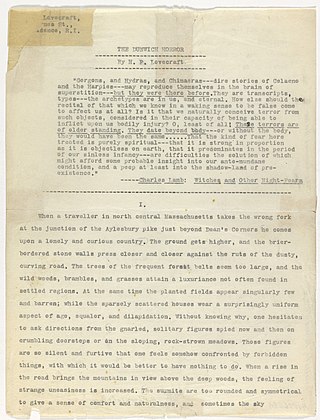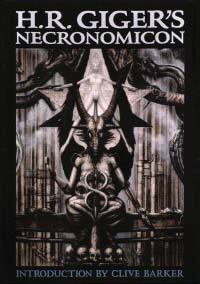
Hans Ruedi Giger was a Swiss artist best known for his airbrushed images that blended human physiques with machines, an art style known as "biomechanical". He was part of the special effects team that won an Academy Award for the visual design of Ridley Scott's 1979 sci-fi horror film Alien, and was responsible for creating the titular Alien itself. His work is on permanent display at the H.R. Giger Museum in Gruyères, Switzerland. His style has been adapted to many forms of media, including album covers, furniture, tattoos and video games.

The Necronomicon, also referred to as the Book of the Dead, or under a purported original Arabic title of Kitab al-Azif, is a fictional grimoire appearing in stories by the horror writer H. P. Lovecraft and his followers. It was first mentioned in Lovecraft's 1924 short story "The Hound", written in 1922, though its purported author, the "Mad Arab" Abdul Alhazred, had been quoted a year earlier in Lovecraft's "The Nameless City". Among other things, the work contains an account of the Old Ones, their history, and the means for summoning them.

Ramsey Campbell is an English horror fiction writer, editor and critic who has been writing for well over fifty years. He is the author of over 30 novels and hundreds of short stories, many of them winners of literary awards. Three of his novels have been adapted into films.

Richard Corben was an American illustrator and comic book artist best known for his comics featured in Heavy Metal magazine, especially the Den series which was featured in the magazine's first film adaptation in 1981. He was the winner of the 2009 Spectrum Grand Master Award and the 2018 Grand Prix at Angoulême. In 2012 he was elected to the Will Eisner Award Hall of Fame.

At the Mountains of Madness is a science fiction-horror novella by American author H. P. Lovecraft, written in February/March 1931. Rejected that year by Weird Tales editor Farnsworth Wright on the grounds of its length, it was originally serialized in the February, March, and April 1936 issues of Astounding Stories. It has been reproduced in numerous collections.

"The Colour Out of Space" is a science fiction/horror short story by American author H. P. Lovecraft, written in March 1927. In the tale, an unnamed narrator pieces together the story of an area known by the locals as the "blasted heath" in the hills west of the fictional town of Arkham, Massachusetts. The narrator discovers that many years ago a meteorite crashed there, poisoning every living being nearby: vegetation grows large but foul-tasting, animals are driven mad and deformed into grotesque shapes, and the people go insane or die one by one.

The xenomorph is a fictional endoparasitoid extraterrestrial species that serves as the titular main antagonist of the Alien and Alien vs. Predator franchises.

Species is a 1995 American science fiction horror film directed by Roger Donaldson and written by Dennis Feldman. It stars Ben Kingsley, Michael Madsen, Alfred Molina, Forest Whitaker, Marg Helgenberger, and Natasha Henstridge in her film debut role. The film's plot concerns a motley crew of scientists and government agents who try to track down Sil (Henstridge), a seductive extraterrestrial-human hybrid, before she successfully mates with a human male.

Frank Belknap Long Jr. was an American writer of horror fiction, fantasy, science fiction, poetry, gothic romance, comic books, and non-fiction. Though his writing career spanned seven decades, he is best known for his horror and science fiction short stories, including contributions to the Cthulhu Mythos alongside his friend, H. P. Lovecraft. During his life, Long received the World Fantasy Award for Life Achievement, the Bram Stoker Award for Lifetime Achievement, and the First Fandom Hall of Fame Award (1977).

Tsutomu Nihei is a Japanese manga artist. Nihei has been drawing comics professionally since the mid-1990s. In 1995 he was awarded the Jiro Taniguchi Special Prize in that year's Afternoon Four Seasons Award for his submission, Blame. After working as an assistant to veteran comic artist Tsutomu Takahashi, Nihei went on to launch his debut series Blame! in Monthly Afternoon in 1997. Following the success of Blame!, he next penned Wolverine: Snikt! and Biomega. In 2009, Nihei returned to Afternoon to launch what would become his most successful series, Knights of Sidonia. An architectural student, Nihei's early work were mainly wordless, relying on visuals and backgrounds to tell their stories. His cyberpunk-influenced artwork has gained a strong cult following worldwide.

"The Dunwich Horror" is a horror novella by American writer H. P. Lovecraft. Written in 1928, it was first published in the April 1929 issue of Weird Tales (pp. 481–508). It takes place in Dunwich, a fictional town in Massachusetts. It is considered one of the core stories of the Cthulhu Mythos.

"The Haunter of the Dark" is a horror short story by American author H. P. Lovecraft, written between 5–9 November 1935 and published in the December 1936 edition of Weird Tales. It was the last written of the author's known stories and is part of the Cthulhu Mythos. The epigraph to the story is the second stanza of Lovecraft's 1917 poem "Nemesis".
Unaussprechliche Kulte is a fictional book of arcane literature in the Cthulhu Mythos. The book first appeared in Robert E. Howard's 1931 short stories "The Children of the Night" and "The Black Stone" as Nameless Cults. Like the Necronomicon, it was later mentioned in several stories by H. P. Lovecraft.

Lovecraftian horror, also called cosmic horror or eldritch horror, is a subgenre of horror, fantasy fiction and weird fiction that emphasizes the horror of the unknowable and incomprehensible more than gore or other elements of shock. It is named after American author H. P. Lovecraft (1890–1937). His work emphasizes themes of cosmic dread, forbidden and dangerous knowledge, madness, non-human influences on humanity, religion and superstition, fate and inevitability, and the risks associated with scientific discoveries, which are now associated with Lovecraftian horror as a subgenre. The cosmic themes of Lovecraftian horror can also be found in other media, notably horror films, horror games, and comics.

A Giger Bar is a bar themed and modelled by the Swiss artist H. R. Giger. There are two Giger Bars: the first, the H.R. Giger Bar in Chur, Switzerland, which opened in 1992, and the second is The Museum HR Giger Bar, located in Château St. Germain, Gruyères, Switzerland, which opened on April 12, 2003.
Necronomicon Press is an American small press publishing house specializing in fiction, poetry and literary criticism relating to the horror and fantasy genres. It is run by Marc A. Michaud.
The Necronomicon is a fictional grimoire from the stories of horror writer H. P. Lovecraft.

Alien is a 1979 science fiction horror film directed by Ridley Scott and written by Dan O'Bannon, based on a story by O'Bannon and Ronald Shusett. It follows a spaceship crew who investigate a derelict spaceship and are hunted by a deadly extraterrestrial creature. The film stars Tom Skerritt, Sigourney Weaver, Veronica Cartwright, Harry Dean Stanton, John Hurt, Ian Holm, and Yaphet Kotto. It was produced by Gordon Carroll, David Giler, and Walter Hill through their company Brandywine Productions and was distributed by 20th Century-Fox. Giler and Hill revised and made additions to the script; Shusett was the executive producer. The alien creatures and environments were designed by the Swiss artist H. R. Giger, while the concept artists Ron Cobb and Chris Foss designed the other sets.
Biomechanical art is a surrealistic style of art that combines elements of machines with organics. Rendered with distinct realism, biomechanical art expresses an internal fantasy world, most typically represented with human or animal anatomy where bones and joints are replaced with metal pistons and gears, but infused with muscles and tendons.















